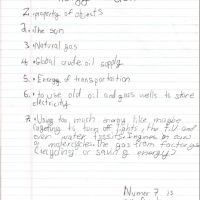Lights Out!

 Every once in a while we like to ask for a little help with ideas for our Key Findings. This month we asked Lauren Keating, an incoming fourth-grader at Eagle Springs Elementary School, what she thought might be some interesting topics related to Energy. She came up with some great ideas, and like her, number 7 was our favorite too.
Every once in a while we like to ask for a little help with ideas for our Key Findings. This month we asked Lauren Keating, an incoming fourth-grader at Eagle Springs Elementary School, what she thought might be some interesting topics related to Energy. She came up with some great ideas, and like her, number 7 was our favorite too.
Lauren’s list:
- Property of objects
- The Sun
- Natural gas
- Global crude oil supply
- Energy of transportation
- To use old oil and gas wells to store electricity
- Using too much energy like maybe forgetting to turn off lights, the T.V. and even water fossits. Ingines on cars or motorcycles. The gas from factorys (recycling or saving energy).
Number 7 is my favorite
-Lauren
Seeing is believing, and it seems that most Americans believe that the items they actually see or come into the most frequent contact with are their biggest energy drains. The truth is things like lights, computers and TVs require far less energy than those things we don’t think about regularly, such as hot water heaters and even automobiles.
Nobel Prize-winning psychologist Daniel Kahneman hypothesized that this is caused by a mental shortcut known as availability heuristic, which leads people to misperceive the likelihood of an event occurring because they’re relying on how easily it pops into their mind. In the context of energy use, Dan R. Schley and Michael L. DeKay refer to a closely related concept that they call “cognitive accessibility.” The idea is that a device you use or think about regularly will be more cognitively accessible than one that you barely ever see or operate. And then you’ll think it uses more energy than it actually does. Americans appear to use the frequency that they interact with and think about various energy-consuming devices when estimating relative energy consumption.
People are not very good at estimating how much total energy is consumed by the different categories, not realizing for example, that home heating and driving private motor vehicles are dramatically more energy intensive than many other smaller energy users, such as computers or dishwashers. In one study, people estimated that home heating took up seven percent of energy use, whereas the actual figure is closer to 20 percent. Most Americans still turn off appliances at home in order to save electricity, but the percentage is down to 75 percent from 79 percent in 2014 and 82 percent in 2012. According to 2005 data, home heating is the single greatest consumer of energy within homes across the nation followed by water heating, air conditioning and lighting. And while not always considered a “residential” form of energy use, vehicle driving takes up even more energy than home heating.
Conserving energy is important from many aspects, including environmental and financial. But if people aren’t aware of their consumption in real terms, then they are less likely to take the necessary steps to cut their energy use. If we misperceive how we use energy or how much of it we use in certain tasks or end uses, then while our intentions are good, we may end up cutting back in the wrong places.
So yes, turn off the lights. That is definitely a great start. But also, be mindful of things like water heaters and insulation and weatherizing. Of course in Texas it is hard to imagine that heating our homes could be an issue, and it is far more likely that cooling costs more for us.
Bullets
- U.S. regular gasoline monthly average retail prices reached a 2015 high of $2.72/gallon (gal) in May, an increase of 25¢/gal from April.
eia.gov
- A new study finds an association between living close to fracking wells and babies who were born small for their gestational age.
journals.plos.org
- There are still 2.5 million Americans who have been unemployed for half a year or longer and are still actively searching for work. Nearly 29 percent of all unemployed workers fall into this long-term unemployed category. The average length of time someone has spent unemployed is about seven and a half months, nearly double what it was right before the recession.
americanprogress.org
- EIA forecasts that the average U.S. residential electricity customer will spend 4.8 percent more during the upcoming summer months than during the same period last year. This increase in the average residential bill reflects a projected 2.6 percent increase in average electricity usage and a 2.1 percent increase in the average retail price of electricity.
eia.gov
- The U.S. Energy Information Administration recently indicated that non-hydro storage capacity in the United States has doubled in the last five years, to 350 MW. A report from Greentech Media and the Electricity Storage Association estimated that the U.S. energy storage market grew 40 percent in 2014 over the previous year, adding 62 MW of storage–and they predict an additional 220 MW will come online in 2015.
brookings.edu
